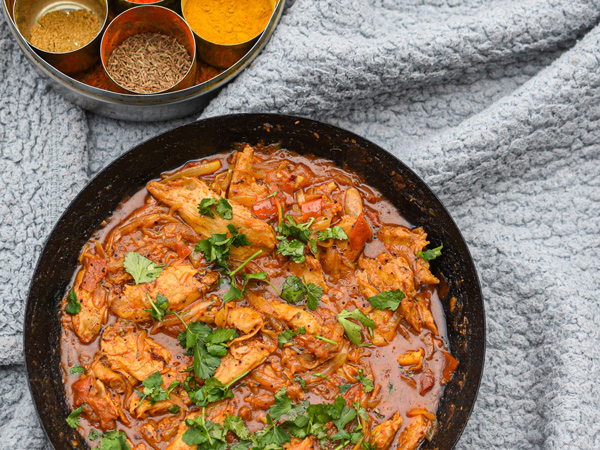All it takes is knowledge, time, love and patience, the “somer gooi alles in” attitude is never going to produce the depth of flavour that a comforting curry has.
A curry is a hug in a bowl, that instant warm, comfort on a cold day or your worst day. Here’s how you can achieve your own comforting South African Indian Curry.
Let’s start by explaining the need for each key vegetable as well as how to extract the most flavour from each of them.
Onions
Onions are the soul of the curry, the time and love that is put into caramelising the onions is transformed into tons of taste when eating the curry. Onions are usually sliced or diced then gently fried in either oil, butter or ghee until golden brown or dark brown depending on the depth of the taste one wishes to achieve. Apart from flavour, onions also add body to a curry, since they are often one of the first ingredients in a curry they do usually break down and form part of the thickening agents in a curry.
Ginger is sometimes sliced, pounded or grated and added to the curry base. It adds warm earthy undertones as well as providing other benefits, ginger is a natural way of settling the stomach. It also provides the aromatic part of the dish. It is also always used in meat curries as it is a natural meat tenderizer.
Garlic, like the ginger, is either sliced, pounded or grated then added once the onions are translucent. They greatly aid in aromatics as well as for its health benefits.
Most South African Curries have tomatoes in them to make a gravy or curry sauce. As they cook and break down the add tang, taste, acidity and thickness. They absorb the flavours and tastes of the spices and bring them together to celebrate a symphony of flavours. There are many ways of adding tomatoes, fresh, tinned, pureed or in the form of paste.
Potatoes were originally added to meat curries as a way of “stretching” the curry. Meat prices were way higher than vegetable prices and when families usually added in potatoes 500g of meat could feed five not three.
Now for the herbs.
Please note Curry leaf is a herb and not the same as Curry Powder(will be explained when discussing spices). Curry leaf is a herb from the curry leaf plant, originally of South Indian origin, that is found in almost every Indian home and added to practically every curry. The best flavours are extracted when fried in hot oil with the dry whole spices. They work perfectly when tempering spices for Dhalls and Braised Curries.
Most often Coriander is added as a garnish that adds extra freshness as well as an earthy taste that comes from no other herb but if chopped finely and added in when the onions, whole spices, garlic and ginger is cooking then the flavour is heightened and amplified as the curry cooks.
As with Coriander mint is most flavourful if added to the curry when the onions, whole spices, garlic and ginger are cooking then the flavour is heightened and amplified as the curry cooks.
Fresh Chilli is added to curry to add heat although sometimes it is like playing
Russian Roulette as you never know how hot they really are until added. Removing the seeds allows the chilli to impart its flavour not heat.
By definition it is a combination of spices used in Indian Cooking. Most Indian homes had their own secret blends as do the 29 Indian States in India. Masala is usually made by roasting and grinding whole spices, amounts as well as the whole spices added vary but the result is wonderful.
Now most pick up their preferred blend from the local spice shops, varieties include Kashmiri (North Indian combination with Kashmiri Chillies as the base), Rombo Rossi (South Indian combination with Chilli as the base), Mother-in-Law (South African combination more for a hot curry), Garam (a combination of brown spices No chilli), Curry Powder – a blend of cumin, coriander, turmeric, black pepper No chilli.
Find a blend or even a combination of blends that works for you and your family. Remember the best way to extract maximum flavour from masala is to allow it to fry gently in the oil/butter/ghee, as it blooms it transfers flavour but be very careful not to burn.
Cinnamon sticks, green cardamom, cumin seeds, coriander seeds, bay leaves, mustard seeds and anise are all examples of aromatics that can be added to a curry. Roast them dry in the pot before adding oil/butter/ghee. Quantities and combinations are totally up to the individual as some prefer powders to the whole spices as there is less to pick out as biting into some of these can be polarising and spoil the meal.

